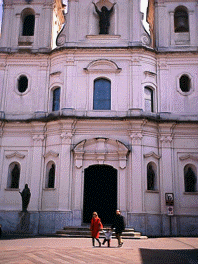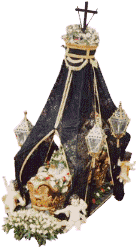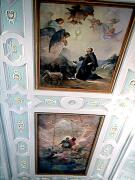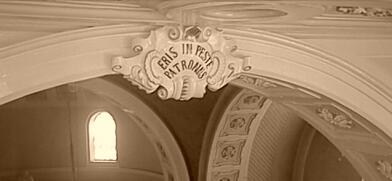 |
The Churches
 |


|
|
The Main Church |
|
 Its construction began after the 1783 earthquake thanks to Maria Antonia Grimaldi, daughter and heir
of Maria Teresa, Princess of Gerace, who died under the earthquake rubble and was later buried in the
Chapel of the Immacolata.
Its construction began after the 1783 earthquake thanks to Maria Antonia Grimaldi, daughter and heir
of Maria Teresa, Princess of Gerace, who died under the earthquake rubble and was later buried in the
Chapel of the Immacolata.
The Grimaldi, who were a noble Genoese family, bought the "Marquisate of Gerace" from De Marinis,
another Genoese nobleman who had in turn acquired it from D.Consalvo Ferdinando de Cordoba who
was the Marquis of Gerace during the period of the Spanish domination.
Battista Grimaldi's successor was Giovan Francesco and later Girolamo to whom Filippo III in 1609
granted the title of Prince of Gerace. Then, from father to son it reached Maria Teresa and her daughter
Maria Antonia. The family estate of Gerace ended with Princess Maria Antonia Serra and the abolition
of feudalism.
The church was given a late baroque look by the work of the architects of Polistena the Morani
brothers.
The bell, reforged in 1819, bears the image of St. Gerolamus who the Grimaldi named as their land
Saint Protector and today he still is the city's saint patron.
The wooden statue is the work of the
sculptor Domenico De Lorenzo (1740-1812) who also made the statue of the resurrected Christ.
 The parish also has statues that represent the Passion of Christ, by the sculptor Francesco Biangardi
who lived in the 19th century. Biangardi was born in Naples on 24.02.1832 and died in Caltanissetta in 1911. His son Vincenzo had
great talent but was assassinated on 24.09.1890 at age 30.
The parish also has statues that represent the Passion of Christ, by the sculptor Francesco Biangardi
who lived in the 19th century. Biangardi was born in Naples on 24.02.1832 and died in Caltanissetta in 1911. His son Vincenzo had
great talent but was assassinated on 24.09.1890 at age 30.
The statues of the passion, the so called "Mysteries" represent scenes from the passion and begin with
"Christ in the olive grove" and end with "The death of Christ" and the "Addolorata".
They are carried and paraded through the town streets on Good Friday.
The statues of the Mysteries are the most important in terms of number, scene and size with evident
reference to the iconographic history of the art.
The group of "Piety" signed and dated 1866, is reminiscent of a similar 15th century work by the Carracci. The Dead Christ resembles works of the Neapolitan 16th century. The angels came from the workshop of the Morani brothers of Polistena.
The paintings decorating the ceiling are the work of Cittanova's artist Raffaele Raso.
[to be continued >>>]
|
|
The Church of the Holy Rosary (SS.Rosario) |
|
This church was built in 1820, commissioned by Don Domenico Maria Siciliani. The façade is
embellished by the statue of the Madonna, a work by Francesco Jerace. [to be continued >>>]
|
|
The church of San Rocco |
|
 The construction of this church began in around 1835 under request of Vincenzo Zito and the plan of
the architect Vincenzo Tarsitani. It was completed by Don Girolamo Pietropaolo after almost 70 years
and the original plan was also modified. The façade had been originally planned to face the road that
lead to the 'Passo del Mercante' and joined the town with the Ionian coast. This is the largest of all the
churches of the area. The paintings are by Prof. Giuseppe R. Moretti (1868-1930).
The construction of this church began in around 1835 under request of Vincenzo Zito and the plan of
the architect Vincenzo Tarsitani. It was completed by Don Girolamo Pietropaolo after almost 70 years
and the original plan was also modified. The façade had been originally planned to face the road that
lead to the 'Passo del Mercante' and joined the town with the Ionian coast. This is the largest of all the
churches of the area. The paintings are by Prof. Giuseppe R. Moretti (1868-1930).





The feast of San Rocco is held on
the third Sunday of September. A country Fair approved by a decree of King Ferdinand II in 1843, was
held in the three days preceding the feast and animals and land products were traded.
 The organ of the church The organ of the church
|
|
The Holy Family Church |
|
Its building goes back to the year 1887. It was built in just 32 months upon request by Donna Rosa
Tarsitani. [to be continued >>>]
|
|
The church of the Madonna della Catena (Madonna of the Chain) |
|
This church was built following the cholera epidemic of 1854 on the site of the little church of S.Maria
di Campoforano. The idea to build this church is accredited to archpriest D. Domenico Luzio (between
1854 and 1860). S.Maria of Campoforano had been erected by the villagers of nearby Morgeto. [to be continued >>>]
|
|
Other Churches |
|
The other churches are those in honor of the saints Cosma and Damiano. The church of S. Giuseppe built near the church of S.Francesco destroyed by the 1783 earthquake. The church of Calvario built in 1912 by architect Domenico Avenoso. In the hamlet of Malizia there is the church of Madonna delle
Grazie e Misericordia where a 1901 painting by the Messina artist Giuseppe Bonaccorso can be seen.
In this small church there is also a painting of the same Madonna but from the Neapolitan art
school. The church bells have different dates, 1752 on one and 1818 on the other.
(translation by Martino De Marco)
Nativo di San Martino (Reggio Calabria) e residente in Adelaide, dove ha conseguito una laurea in lettere, Martino De Marco esercita la professione di traduttore ed interprete. Appassionato della sua "Piccola Patria" lontana, De Marco da anni ha voluto conoscere meglio
la Calabria, facendo anche varie ricerche in internet.
Il primo luglio 2005 è stato presentato in Adelaide la versione in inglese del romanzo, "Valpatri House" di Nadia Crucitti, tradotta appunto da De Marco e stampata localmente in tiratura ridottissima. Il lancio di questo "atto di affetto" e disponibilità professionale è stato fatto nel corso di una serata culturale organizzata per l'occasione. Ha presentato il libro la dottoressa Maria Grazia Re, direttrice didattica del Consolato d'Italia, alla presenza di personalità del mondo della cultura, delle istituzioni e dell'associazionismo locale.
|





 The parish also has statues that represent the Passion of Christ, by the sculptor Francesco Biangardi
who lived in the 19th century. Biangardi was born in Naples on 24.02.1832 and died in Caltanissetta in 1911. His son Vincenzo had
great talent but was assassinated on 24.09.1890 at age 30.
The parish also has statues that represent the Passion of Christ, by the sculptor Francesco Biangardi
who lived in the 19th century. Biangardi was born in Naples on 24.02.1832 and died in Caltanissetta in 1911. His son Vincenzo had
great talent but was assassinated on 24.09.1890 at age 30.


